Unit 4 Don't eat in class.Section A (1a-2c)课件(共44张PPT,含音频)
文档属性
| 名称 | Unit 4 Don't eat in class.Section A (1a-2c)课件(共44张PPT,含音频) |  | |
| 格式 | zip | ||
| 文件大小 | 5.8MB | ||
| 资源类型 | 教案 | ||
| 版本资源 | 人教新目标(Go for it)版 | ||
| 科目 | 英语 | ||
| 更新时间 | 2022-03-23 08:17:45 | ||
图片预览


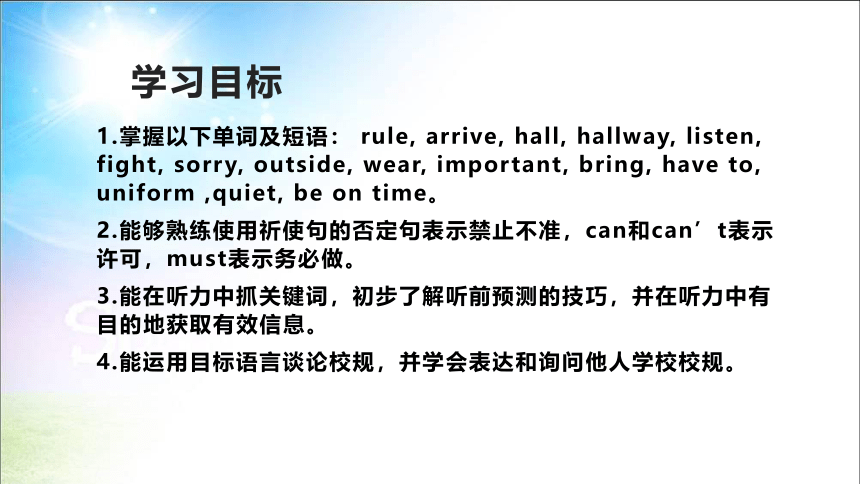
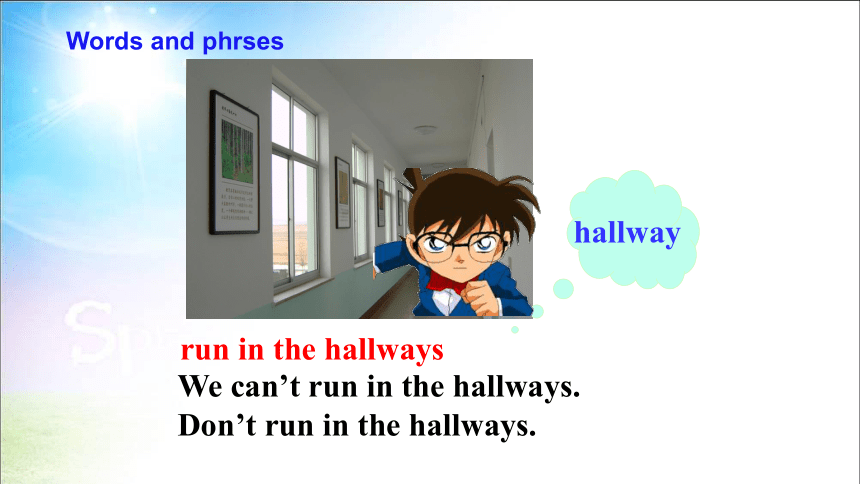

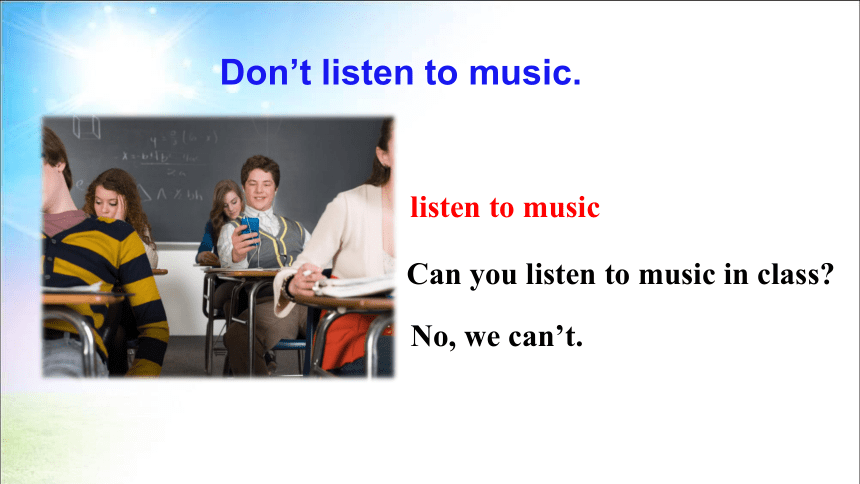

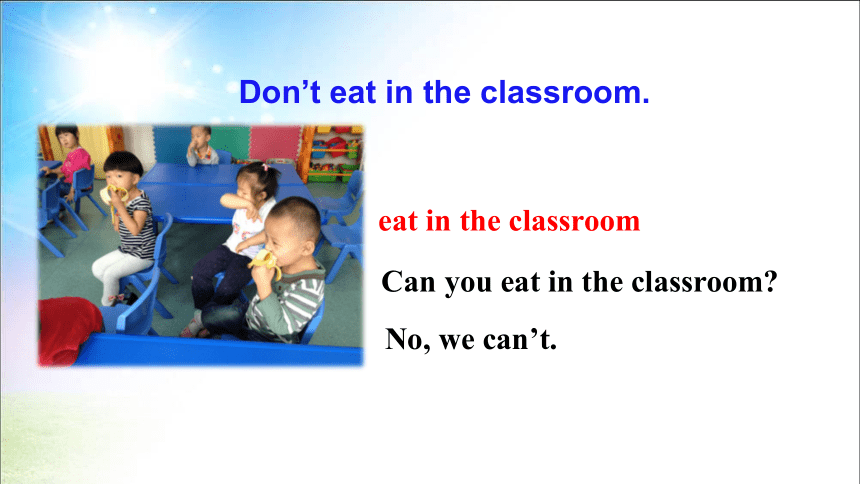


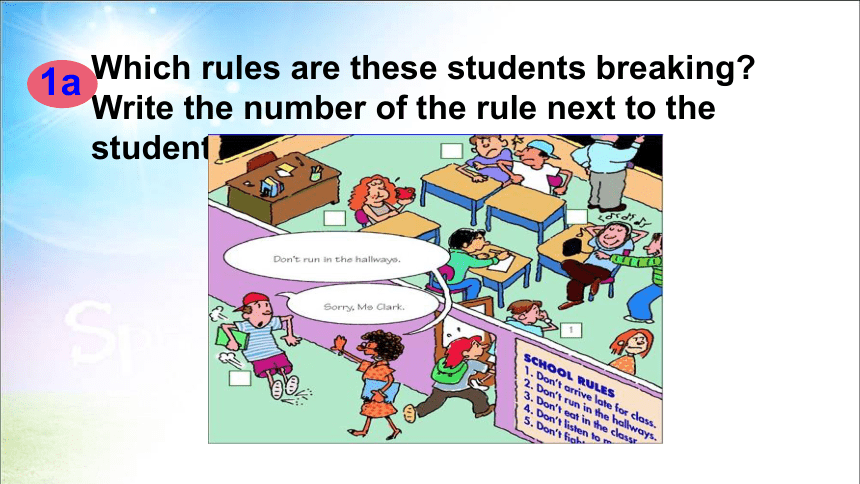

文档简介
(共44张PPT)
Unit 4
Unit 4
Don’t eat in class.
Section A(1a-2d)
学习目标
1.掌握以下单词及短语: rule, arrive, hall, hallway, listen, fight, sorry, outside, wear, important, bring, have to, uniform ,quiet, be on time。
2.能够熟练使用祈使句的否定句表示禁止不准,can和can’t表示许可,must表示务必做。
3.能在听力中抓关键词,初步了解听前预测的技巧,并在听力中有目的地获取有效信息。
4.能运用目标语言谈论校规,并学会表达和询问他人学校校规。
hallway
We can’t run in the hallways.
Don’t run in the hallways.
run in the hallways
Words and phrses
fight
We can’t fight. Don’t fight!
listen to music
Can you listen to music in class
No, we can’t.
Don’t listen to music.
arrive late for school= be late for school
We can’t be late for school.
We must be on time (for school).
=Don’t be late for school.
Don’t arrive late for school.
eat in the classroom
Can you eat in the classroom
No, we can’t.
Don’t eat in the classroom.
Nothing can be accomplished
without norms or standards.
无规矩不成方圆。
We can’t rule the country without rules.
没有规章制度就不能治理好国家。
keep rules
break rules
school rules
class rules
family rules
library rules
dining rules
遵守规则
违反规则
校规
班规
家规
图书馆规则
就餐规则
Which rules are these students breaking Write the number of the rule next to the student.
1a
1. Don’t arrive late for class. You must be on time.
2. Don’t run in the hallways.
3. Don’t eat in the classroom. You must eat in the dining
hall.
4. Don’t listen to music in class.
5. Don’t fight.
SCHOOL RULES
2
3
4
5
Peter _____
Amy _____
Mike _____
Listen. What rules are these students breaking
Write the numbers after the names.
2
3
4
1b
1c Student A is a new student. Student B tells Student A about the rules above.
A: What are the rules
B: Well, we can’t arrive late for class. We must be on time.
What are the rules
Well, we can’t run in the hallways.
What are the rules
Well, we can’t eat in the classroom. We must eat in the dining hall.
Listen. Check the activities Alan
and Cindy talk about.
Activity
1. ___ listen to music in the classroom or hallways can can’t
2. ___ listen to music in the music room can can’t
3. ___ listen to music outside can can’t
4. ___ eat in the classroom can can’t
5. ___ eat in the dinning hall can can’t
6. ___ eat outside can can’t
7. ___ wear a hat can can’t
8. ___ fight can can’t
√
√
√
√
√
√
√
2a
Listen again. Can Alan and Cindy do these
activities Circle “can” or “can’t” above.
2b
Activity 1. ___ listen to music in the classroom or hallways can can’t
2. ___ listen to music in the music room can can’t
3. ___ listen to music outside can can’t
4. ___ eat in the classrooms can can’t
5. ___ eat in the dinning hall can can’t
6. ___ eat outside can can’t
7. ___ wear a hat can can’t
8. ___ fight can can’t
√
√
√
√
√
√
√
Fill in the blanks.
Cindy: What are the school rules, Alan
Alan: Well, we can’t listen to music
_______________________. But we can listen to it________________________ .
Cindy: Uh-huh.
in the classroom or hallways
outside or in the music room
Alan: And we can’t eat in the _________, but we
can eat in the _____________.
Cindy: Oh. And can we wear a hat in class
Alan: ____________. What else Oh, you can’ t
_________ your classmates. That makes the
teachers really unhappy.
Cindy: I see…
classroom
dining hall
fight with
No, we can’t
Cindy: What are the school rules, Alan
Alan: Well, we can’t listen to music in the
classroom or hallways. But we can
listen to it outside or in the music room.
Cindy: Uh-huh.
Tapescripts
Alan: And we can’t eat in the classroom, but we
can eat in the dining hall.
Cindy: Oh. And can we wear a hat in class
Alan: No, we can’t. What else Oh, you can’ t
fight with your classmates. That makes the
teachers really unhappy.
Cindy: I see…
2c
Student A is Alan and Student B is Cindy. Talk about the rules in 2a.
Can we listen to music,Cindy
We can’t listen to music in the hallways, but we can listen to it outside.
祈使句
1.祈使句是表示命令/叮嘱/号召等的句子;
2.通常省略主语you;
3.句中谓语动词用动词原形;
4.祈使句有肯定和否定两种:
肯定:
Come in, please! 请进!
Sit down, please. 请坐。
否定:
Don’t eat in class.
Don’t play sports in the classroom.
Don’t fight.
1.请保持安静!
2.请把你的家庭作业带到学校来。
3.请不要在教室里吃东西。
4. 在六点钟之前请不要离开这里。
Please be quiet!
Please bring your homework to school.
Please don't eat in the classroom.
Please don't leave here before six.
小试牛刀
Language points
1. arrive vi. 到达
When did he arrive yesterday
昨天他什么时候到达的?
arrive in / at与get to 的区别
① My father arrived in / got to Beijing this morning.
我爸爸今天上午到达了北京。
② The farmer arrived at / got to an old house and knocked at the door.
那个农民到达了一个旧房子前并且敲了敲门。
小结:
arrive + in (大地方)
at (小地方)
get 必须与to 搭配才能加宾语。后面如接地点副词,则不用介词to。
– When did your uncle ______ in Shanghai
– The day before yesterday.
A. arrive B. get
If you _____ too late, the host will be unhappy.
A. arrive B. get to C. arrive at
___________ (not arrive) late for class.
A
A
Don’t arrive
2. 1) must 作为情态动词,表示“必须”、“务必”,有时还表示“一定”,起到加强语气的作用。例如:
You must come tomorrow.
你(们)明天必须要来。
在回答must引起的问句时,如果是否定的答复,可用don’t have to或needn’t (不必) , 但不能用mustn’t (一定不, 必须不, 不允许, 不得) 。
--- ______ ask you some questions
--- Sure.
A. Do you B. Will you
C. Can I D. Must I
-Dad, may I watch TV
-No, you can’t. You _______ finish your homework first.
A. must B. can C. may
C
A
2) on time 是一个固定介词短语,表示“按时;准时”。 例如:
We must get to school on time.
我们必须按时到校。
我们要按时完成任务。
We'll finish our job _________.
on time
3) 系动词be与形容词或介词短语联用,是英语一种常见的语句结构,表示某种状态。例如:
be quiet 保持安静;be strict 要求严格
be on time 守时;按时到
be at work 在上班
例如:
You mustn’t be noisy, children.
孩子们,你们一定不能喧闹。
3. listen to … 听……
She is listening to the radio.
她在听收音机。
listen at the door 耳朵贴着门听
listen for … 留神等着听…
listen for an answer 等着听回答
listen to a lecture 听讲座
listen to advice 听从劝告
4. wear a hat 戴帽子
wear v. 穿;戴
The girl often wears a red coat and a white hat.
这个女孩经常穿着红色的上衣戴着白色的帽子。
wear强调“穿着”这一状态,也可表示“戴着”。如:
She likes wearing colorful clothes.
她喜欢穿着颜色鲜艳的衣服。
dress既可表示动作,又可表示状态,常由人作宾语,意为“给……穿衣服”。如:Could you dress the child for me 你能不能替我给小孩穿上衣服
wear, dress 与 put on的区别
当表示自己穿衣服时,一般用get dressed (= dress oneself)。 如:
He cannot get dressed( = dress himself).
他不会自己穿衣服。
当dress表示状态时,一般要用be dressed in的形式。如:
She is dressed in a red coat.
她穿着一件红色的上衣。
put on着重于“穿”这一动作,即由没穿到穿这一过程的完成,意为“穿上”。如:
Please put on your new coat.
请穿上你的新大衣。
用 wear, put on, dress 的适当形式填空。
1. She is _________ a red flower in her hair.
2. He ________ his coat and goes out.
3. He is _________ black.
wearing
puts on
dressed in
1. Sit down.
2. Come in.
3. Eat at home.
Don’t sit down.
Don’t come in.
Don’t eat at home.
把下列祈使句改成否定句。
Exercises
4. Listen to music outside.
5. Do your homework at school.
Don’t listen to music outside.
Don’t do your homework at school.
Follow the rules at school!
Unit 4
Unit 4
Don’t eat in class.
Section A(1a-2d)
学习目标
1.掌握以下单词及短语: rule, arrive, hall, hallway, listen, fight, sorry, outside, wear, important, bring, have to, uniform ,quiet, be on time。
2.能够熟练使用祈使句的否定句表示禁止不准,can和can’t表示许可,must表示务必做。
3.能在听力中抓关键词,初步了解听前预测的技巧,并在听力中有目的地获取有效信息。
4.能运用目标语言谈论校规,并学会表达和询问他人学校校规。
hallway
We can’t run in the hallways.
Don’t run in the hallways.
run in the hallways
Words and phrses
fight
We can’t fight. Don’t fight!
listen to music
Can you listen to music in class
No, we can’t.
Don’t listen to music.
arrive late for school= be late for school
We can’t be late for school.
We must be on time (for school).
=Don’t be late for school.
Don’t arrive late for school.
eat in the classroom
Can you eat in the classroom
No, we can’t.
Don’t eat in the classroom.
Nothing can be accomplished
without norms or standards.
无规矩不成方圆。
We can’t rule the country without rules.
没有规章制度就不能治理好国家。
keep rules
break rules
school rules
class rules
family rules
library rules
dining rules
遵守规则
违反规则
校规
班规
家规
图书馆规则
就餐规则
Which rules are these students breaking Write the number of the rule next to the student.
1a
1. Don’t arrive late for class. You must be on time.
2. Don’t run in the hallways.
3. Don’t eat in the classroom. You must eat in the dining
hall.
4. Don’t listen to music in class.
5. Don’t fight.
SCHOOL RULES
2
3
4
5
Peter _____
Amy _____
Mike _____
Listen. What rules are these students breaking
Write the numbers after the names.
2
3
4
1b
1c Student A is a new student. Student B tells Student A about the rules above.
A: What are the rules
B: Well, we can’t arrive late for class. We must be on time.
What are the rules
Well, we can’t run in the hallways.
What are the rules
Well, we can’t eat in the classroom. We must eat in the dining hall.
Listen. Check the activities Alan
and Cindy talk about.
Activity
1. ___ listen to music in the classroom or hallways can can’t
2. ___ listen to music in the music room can can’t
3. ___ listen to music outside can can’t
4. ___ eat in the classroom can can’t
5. ___ eat in the dinning hall can can’t
6. ___ eat outside can can’t
7. ___ wear a hat can can’t
8. ___ fight can can’t
√
√
√
√
√
√
√
2a
Listen again. Can Alan and Cindy do these
activities Circle “can” or “can’t” above.
2b
Activity 1. ___ listen to music in the classroom or hallways can can’t
2. ___ listen to music in the music room can can’t
3. ___ listen to music outside can can’t
4. ___ eat in the classrooms can can’t
5. ___ eat in the dinning hall can can’t
6. ___ eat outside can can’t
7. ___ wear a hat can can’t
8. ___ fight can can’t
√
√
√
√
√
√
√
Fill in the blanks.
Cindy: What are the school rules, Alan
Alan: Well, we can’t listen to music
_______________________. But we can listen to it________________________ .
Cindy: Uh-huh.
in the classroom or hallways
outside or in the music room
Alan: And we can’t eat in the _________, but we
can eat in the _____________.
Cindy: Oh. And can we wear a hat in class
Alan: ____________. What else Oh, you can’ t
_________ your classmates. That makes the
teachers really unhappy.
Cindy: I see…
classroom
dining hall
fight with
No, we can’t
Cindy: What are the school rules, Alan
Alan: Well, we can’t listen to music in the
classroom or hallways. But we can
listen to it outside or in the music room.
Cindy: Uh-huh.
Tapescripts
Alan: And we can’t eat in the classroom, but we
can eat in the dining hall.
Cindy: Oh. And can we wear a hat in class
Alan: No, we can’t. What else Oh, you can’ t
fight with your classmates. That makes the
teachers really unhappy.
Cindy: I see…
2c
Student A is Alan and Student B is Cindy. Talk about the rules in 2a.
Can we listen to music,Cindy
We can’t listen to music in the hallways, but we can listen to it outside.
祈使句
1.祈使句是表示命令/叮嘱/号召等的句子;
2.通常省略主语you;
3.句中谓语动词用动词原形;
4.祈使句有肯定和否定两种:
肯定:
Come in, please! 请进!
Sit down, please. 请坐。
否定:
Don’t eat in class.
Don’t play sports in the classroom.
Don’t fight.
1.请保持安静!
2.请把你的家庭作业带到学校来。
3.请不要在教室里吃东西。
4. 在六点钟之前请不要离开这里。
Please be quiet!
Please bring your homework to school.
Please don't eat in the classroom.
Please don't leave here before six.
小试牛刀
Language points
1. arrive vi. 到达
When did he arrive yesterday
昨天他什么时候到达的?
arrive in / at与get to 的区别
① My father arrived in / got to Beijing this morning.
我爸爸今天上午到达了北京。
② The farmer arrived at / got to an old house and knocked at the door.
那个农民到达了一个旧房子前并且敲了敲门。
小结:
arrive + in (大地方)
at (小地方)
get 必须与to 搭配才能加宾语。后面如接地点副词,则不用介词to。
– When did your uncle ______ in Shanghai
– The day before yesterday.
A. arrive B. get
If you _____ too late, the host will be unhappy.
A. arrive B. get to C. arrive at
___________ (not arrive) late for class.
A
A
Don’t arrive
2. 1) must 作为情态动词,表示“必须”、“务必”,有时还表示“一定”,起到加强语气的作用。例如:
You must come tomorrow.
你(们)明天必须要来。
在回答must引起的问句时,如果是否定的答复,可用don’t have to或needn’t (不必) , 但不能用mustn’t (一定不, 必须不, 不允许, 不得) 。
--- ______ ask you some questions
--- Sure.
A. Do you B. Will you
C. Can I D. Must I
-Dad, may I watch TV
-No, you can’t. You _______ finish your homework first.
A. must B. can C. may
C
A
2) on time 是一个固定介词短语,表示“按时;准时”。 例如:
We must get to school on time.
我们必须按时到校。
我们要按时完成任务。
We'll finish our job _________.
on time
3) 系动词be与形容词或介词短语联用,是英语一种常见的语句结构,表示某种状态。例如:
be quiet 保持安静;be strict 要求严格
be on time 守时;按时到
be at work 在上班
例如:
You mustn’t be noisy, children.
孩子们,你们一定不能喧闹。
3. listen to … 听……
She is listening to the radio.
她在听收音机。
listen at the door 耳朵贴着门听
listen for … 留神等着听…
listen for an answer 等着听回答
listen to a lecture 听讲座
listen to advice 听从劝告
4. wear a hat 戴帽子
wear v. 穿;戴
The girl often wears a red coat and a white hat.
这个女孩经常穿着红色的上衣戴着白色的帽子。
wear强调“穿着”这一状态,也可表示“戴着”。如:
She likes wearing colorful clothes.
她喜欢穿着颜色鲜艳的衣服。
dress既可表示动作,又可表示状态,常由人作宾语,意为“给……穿衣服”。如:Could you dress the child for me 你能不能替我给小孩穿上衣服
wear, dress 与 put on的区别
当表示自己穿衣服时,一般用get dressed (= dress oneself)。 如:
He cannot get dressed( = dress himself).
他不会自己穿衣服。
当dress表示状态时,一般要用be dressed in的形式。如:
She is dressed in a red coat.
她穿着一件红色的上衣。
put on着重于“穿”这一动作,即由没穿到穿这一过程的完成,意为“穿上”。如:
Please put on your new coat.
请穿上你的新大衣。
用 wear, put on, dress 的适当形式填空。
1. She is _________ a red flower in her hair.
2. He ________ his coat and goes out.
3. He is _________ black.
wearing
puts on
dressed in
1. Sit down.
2. Come in.
3. Eat at home.
Don’t sit down.
Don’t come in.
Don’t eat at home.
把下列祈使句改成否定句。
Exercises
4. Listen to music outside.
5. Do your homework at school.
Don’t listen to music outside.
Don’t do your homework at school.
Follow the rules at school!
同课章节目录
- Unit 1 Can you play the guitar?
- Section A
- Section B
- Unit 2 What time do you go to school?
- Section A
- Section B
- Unit 3 How do you get to school?
- Section A
- Section B
- Unit 4 Don't eat in class.
- Section A
- Section B
- Unit 5 Why do you like pandas?
- Section A
- Section B
- Unit 6 I'm watching TV.
- Section A
- Section B
- Review of Units 1-6
- Unit 7 It's raining!
- Section A
- Section B
- Unit 8 Is there a post office near here?
- Section A
- Section B
- Unit 9 What does he look like?
- Section A
- Section B
- Unit 10 I'd like some noodles.
- Section A
- Section B
- Unit 11 How was your school trip?
- Section A
- Section B
- Unit 12 What did you do last weekend?
- Section A
- Section B
